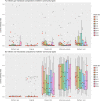The Influence of Different Maternal Microbial Communities on the Development of Infant Gut and Oral Microbiota
- PMID: 28855595
- PMCID: PMC5577157
- DOI: 10.1038/s41598-017-09278-y
The Influence of Different Maternal Microbial Communities on the Development of Infant Gut and Oral Microbiota
Abstract
Very few studies have analyzed how the composition of mother's microbiota affects the development of infant's gut and oral microbiota during the first months of life. Here, microbiota present in the mothers' gut, vagina, breast milk, oral cavity, and mammary areola were compared with the gut and oral microbiota of their infants over the first six months following birth. Samples were collected from the aforementioned body sites from seven mothers and nine infants at three different time points over a 6-month period. Each sample was analyzed with 16S rRNA gene sequencing. The gut microbiota of the infants harbored distinct microbial communities that had low similarity with the various maternal microbiota communities. In contrast, the oral microbiota of the infants exhibited high similarity with the microbiota of the mothers' breast milk, mammary areola and mouth. These results demonstrate that constant contact between microbial communities increases their similarity. A majority of the operational taxonomic units in infant gut and oral microbiota were also shared with the mothers' gut and oral communities, respectively. The disparity between the similarity and the proportion of the OTUs shared between infants' and mothers' gut microbiota might be related to lower diversity and therefore competition in infants' gut microbiota.
Conflict of interest statement
The authors declare that they have no competing interests.
Figures







References
Publication types
MeSH terms
Substances
LinkOut - more resources
Full Text Sources
Other Literature Sources
Medical

